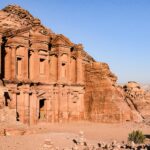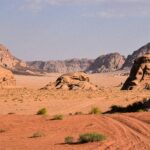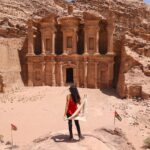![Ein Gedi In Israel - The Complete Guide [2024 Updated] 6 Ein Gedi In Israel](https://artandthensome.com/wp-content/uploads/2023/05/robert-bye-VkZuNpXxdIg-unsplash-1024x683.jpg)
In the heart of the Judean Desert, near the Dead Sea, lies a truly magical place called Ein Gedi in Israel National Reserve. This oasis is one of Israel’s most extraordinary and stunning sites.
Israel is a country of stark contrasts. In just a short distance, you can transition from lush green plains to a desert, from ancient villages to modern skyscrapers, and from a sea teeming with fish to a saltwater sea.
Ein Gedi perfectly exemplifies this contrast. Imagine driving along a road that cuts through the Judean Desert. The landscape consists of rocky plateaus in shades of yellow and ocher, reflecting the intense rays of the sun. Suddenly, the vibrant blue of the Dead Sea emerges amidst this lunar-like scenery, accompanied by the unexpected sight of lush green vegetation.
The combination forms a breathtaking picture, with shapes and colors that defy the imagination of even the boldest painters. Welcome to Ein Gedi.
A Place of Rare Beauty
![Ein Gedi In Israel - The Complete Guide [2024 Updated] 7 Waterfall Ein Gedi In Israel](https://artandthensome.com/wp-content/uploads/2023/05/pexels-haley-black-2102626-683x1024.jpg)
Nestled in the heart of the Judean desert, on the edge of the Dead Sea, lies the extraordinary oasis of Ein Gedi. Covering an area of 25 square kilometers, Ein Gedi National Park boasts exceptional flora, magnificent waterfalls, natural pools, and enchanting trails.
The presence of vibrant vegetation in the middle of the desert is one of the most surprising aspects of this place. The variety of plant species, some of which are endangered, creates a stunning tapestry. Here, you can admire desert date palms, Christ’s thorny jujubes, Sodom apple milkweed, elephant grass, willows, ferns, and much more.
This lush flora thrives thanks to four primary water sources that flow through the rocks, occasionally forming waterfalls or natural pools. The most well-known source is Nahal David.
Ein Gedi is also renowned for its diverse animal species. While it is primarily known for its Nubian ibexes (hence the name “source of the ibexes”), it is also home to rock hyraxes, a type of marmot, as well as jackals and leopards in the higher elevations. Due to its rich fauna and flora, the park was declared a nature reserve in 1972.
A Place for Walking and Hiking
![Ein Gedi In Israel - The Complete Guide [2024 Updated] 8 Walking In Ein Gedi Israel](https://artandthensome.com/wp-content/uploads/2023/05/peter-pryharski-xMkn3toDQsk-unsplash-681x1024.jpg)
Ein Gedi is a popular destination for hiking enthusiasts in Israel. There are nine paths that wind through the rocks and vegetation. Families can enjoy the experience as well, pausing halfway to appreciate the scenery and cool off by dipping their feet in the streams or natural pools. The paths become steeper beyond that point, suitable for experienced hikers who want to continue their ascent.
In the elevated areas of Ein Gedi, you can explore the remains of a temple dating back to the 3rd millennium BC. The inhabitants of that time used to offer animal sacrifices to honor God, as evidenced by the layers of soot on certain rocks.
The Jewish community that once thrived in Ein Gedi seemingly sustained itself by selling a secret balm. This balm, known as Balsam, had sought-after medical and cosmetic properties, and only the inhabitants of Ein Gedi knew its composition. The Romans highly valued this balm.
Within the ruins of the synagogue, you’ll find a magnificent and peculiar mosaic depicting the first 12 generations of men associated with the 12 months of the year and the 12 signs of the zodiac. It also seems to contain a warning against revealing the community’s secrets, including, presumably, the recipe for the balm.
The Kibbutz of Ein Gedi
![Ein Gedi In Israel - The Complete Guide [2024 Updated] 9 View From Kibbutz Hotel In Ein Gedi](https://artandthensome.com/wp-content/uploads/2023/05/211317117-1024x667.jpg)
With nearly 600 members, the Ein Gedi kibbutz is one of the most famous in Israel.
It was created in 1956 in an arid environment. The hard work of the members of this community made it possible to grow beautiful fruits and vegetables to feed its members.
The attractiveness of Ein Gedi and the Dead Sea to tourists slowly led the kibbutz to turn to a new activity: the hotel business. Two cabins were first opened to accommodate those who wished to stay in the region. Mainly people wishing to take advantage of the benefits of the Dead Sea, its exceptionally high salinity rate and its mud baths with beneficial properties for the skin.
Then, faced with the increase in demand, the reception and accommodation of visitors developed to, today, represent the main activity of the kibbutz.
But the kibbutz hotel is special. Indeed, its identity is marked by the pioneering spirit of the kibbutzniks and by their love of the surrounding nature.
It is located in the heart of a botanical garden, which some say is one of the most beautiful in the world, and is oriented towards the well-being of customers. It has a Spa, a sauna, an open swimming pool with an exceptional view and offers numerous relaxation treatments. It serves delicious natural cuisine, made with products grown on site.
The historical and biblical dimension of Ein Gedi
![Ein Gedi In Israel - The Complete Guide [2024 Updated] 10 Couple Hiking In Ein Gedi](https://artandthensome.com/wp-content/uploads/2023/05/robert-bye-N1tdrse98Qg-unsplash-1024x683.jpg)
According to historians, Ein Gedi was already inhabited in the 6th century BC Those who lived there then lived in the caves located in the heights.
The site was then abandoned before being occupied again in the 6th century BC.
The historian Flavius Joseph writes that there were magnificent palm trees there and that a much sought-after balsam was produced there. A small fort was built there in the 2nd century BC Between 60 and 68, the oasis was occupied by a Roman garrison.
But, besides historical testimonies, Ein Gedi is also the setting for several biblical facts.
Indeed, the place is mentioned several times in the Bible.
The most important mention concerns King David. While fleeing King Saul who did not accept David taking his place on the throne, he took refuge in a cave in Ein Gedi with his men.
Saul entered the cave and was at the mercy of David, who could kill him with a swing of his sword. But this one spared him.
Nearby: the Dead Sea and Masada
![Ein Gedi In Israel - The Complete Guide [2024 Updated] 11 Dead Sea Shore Near Masada](https://artandthensome.com/wp-content/uploads/2023/05/pexels-photography-13459743-1024x683.jpg)
You can’t get to Ein Gedi without soaking in the blue waters of the Dead Sea. Located on the other side of the road that serves the national park, this sea with its exceptional salinity rate is renowned for its beneficial properties for the skin.
Masada is also accessible by bus or car. Overlooking the Judean Desert and the Dead Sea, this fortress built by Herod is one of the most visited places in Israel because of its significant historical and symbolic significance. Indeed, it is here that the zealots, rebels to the Roman regime, took refuge and, in order not to fall into the hands of the Roman army, after an implacable siege, preferred to kill themselves rather than be taken prisoner.
FAQ on Ein Gedi
What does Ein Gedi mean?
Ein Gedi means “Spring of the ibexes” concerning the many ibexes that have always moved on the rocky plateaus and go to drink from one of the four springs that cross the nature reserve.
Is Ein Gedi Nature Reserve accessible at all times?
Ein Gedi Nature Reserve is open from 8 a.m. to 4 p.m. in fall and winter and from 8 a.m. to 5 p.m. in spring and summer. More info on their website.
Admission is chargeable-about 7 euro or USD.
How to get to Ein Gedi?
Ein Gedi is located 36 km from Jerusalem and 90 km from Tel Aviv.
The National Park is accessible by car or even by bus, departing from many towns.
Can you get to Masada from Ein Gedi?
138 kilometers separate Ein Gedi and Masada.
You can get from one point to another either by bus or by car.
Can you swim in Ein Gedi Nature Reserve?
You can wade in the shallow waters and pools.
However, the Waterfall swimming is prohibited.





